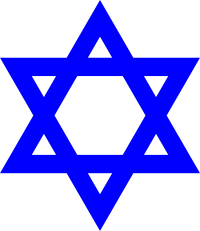
Back نجمة داود Arabic ܡܓܢܐ ܕܕܘܝܕ ARC نجمة داود ARZ David ulduzu Azerbaijani Bitoon ni David BCL Зорка Давіда Byelorussian Зорка Давіда BE-X-OLD Давидова звезда Bulgarian দায়ূদের তারকা Bengali/Bangla ཟུར་དྲུག་མའི་སྐར་མ། Tibetan

The Star of David (Hebrew: מָגֵן דָּוִד, romanized: Magen David, lit. 'Shield of David')[a] is a generally recognized symbol of both Jewish identity and Judaism.[1] Its shape is that of a hexagram: the compound of two equilateral triangles.

A derivation of the Seal of Solomon was used for decorative and mystical purposes by Muslims and Kabbalistic Jews. The hexagram appears occasionally in Jewish contexts since antiquity as a decorative motif, such as a stone bearing a hexagram from the arch of the 3rd–4th century Khirbet Shura synagogue. A hexagram found in a religious context can be seen in a manuscript of the Hebrew Bible from 11th-century Cairo.
Its association as a distinctive symbol for the Jewish people and their religion dates to 17th-century Prague. In the 19th century, the symbol began to be widely used by the Jewish communities of Eastern Europe, ultimately coming to represent Jewish identity or religious beliefs.[2][3] It became representative of Zionism after it was chosen as the central symbol for a Jewish national flag at the First Zionist Congress in 1897.[4]
By the end of World War I, it was an internationally accepted symbol for the Jewish people, used on the gravestones of fallen Jewish soldiers.[5]
Today, the star is the central symbol on the national flag of the State of Israel.
Cite error: There are <ref group=lower-alpha> tags or {{efn}} templates on this page, but the references will not show without a {{reflist|group=lower-alpha}} template or {{notelist}} template (see the help page).
- ^ Jacob Newman; Gabriel Sivan; Avner Tomaschoff (1980). Judaism A–Z. World Zionist Organization. p. 116.
- ^ Cite error: The named reference
Oxfwas invoked but never defined (see the help page). - ^ "The Flag and the Emblem" (MFA).
- ^ "The Flag and the Emblem" (MFA). "The Star of David became the emblem of Zionist Jews everywhere. Non-Jews regarded it as representing not only the Zionist current in Judaism, but Jewry as a whole."
- ^ Cite error: The named reference
Reuveni2017was invoked but never defined (see the help page).